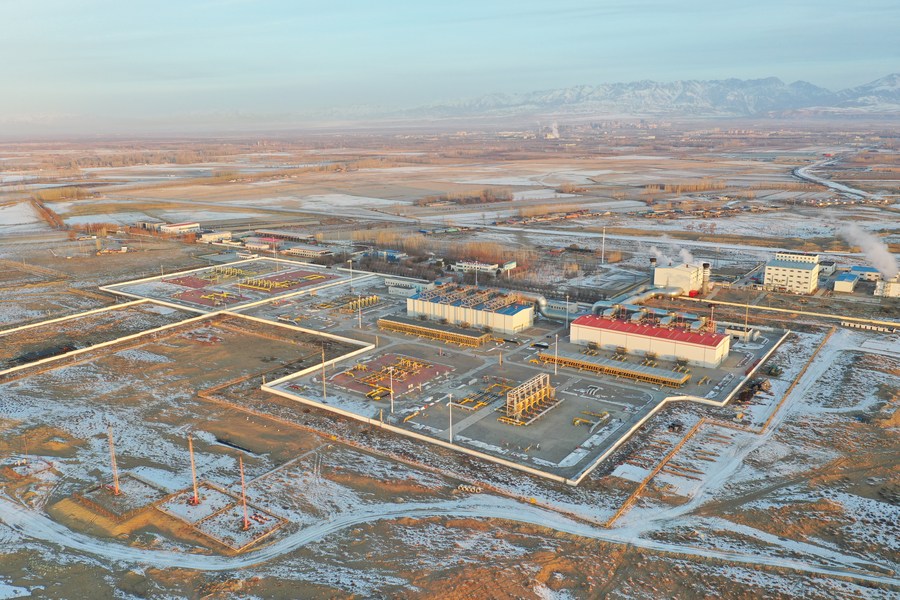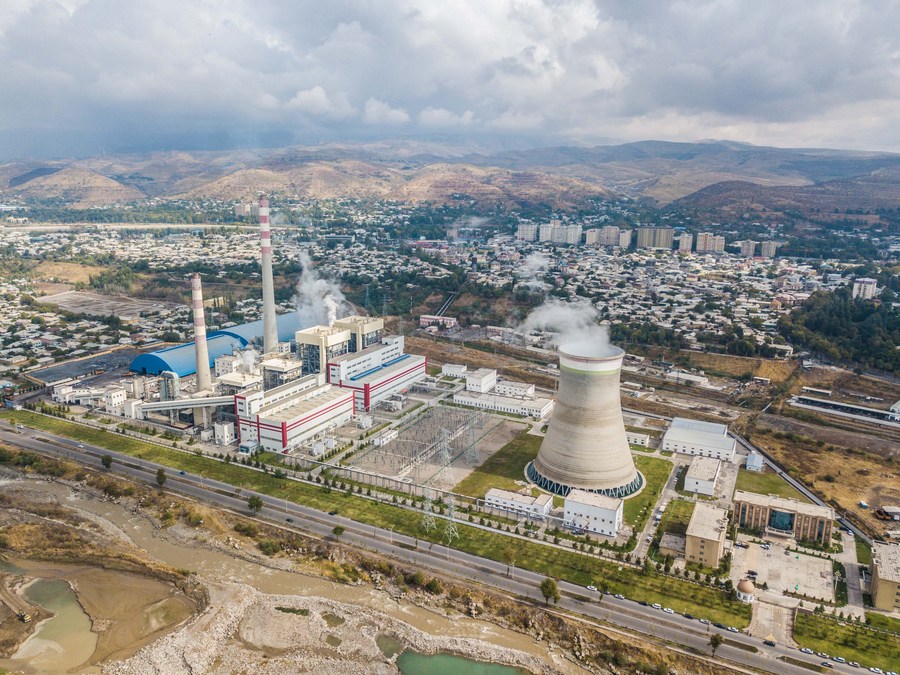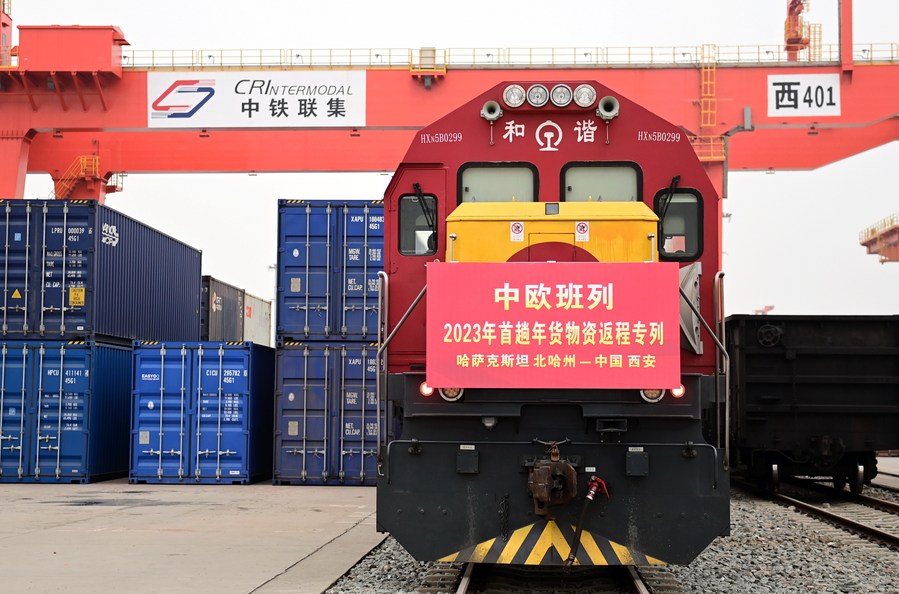
The Horgos initial compressor station, the first station of the China-Central Asia Gas Pipeline in Horgos, northwest China's Xinjiang Uygur Autonomous Region, February 4, 2021. /Xinhua
The Horgos initial compressor station, the first station of the China-Central Asia Gas Pipeline in Horgos, northwest China's Xinjiang Uygur Autonomous Region, February 4, 2021. /Xinhua
Over 2,000 years ago, an envoy from China's Han Dynasty traveled westward on a mission of peace and opened an overland route connecting the East and the West. Stretching thousands of miles and years, the ancient Silk Road, with its longest span straddling Central Asia, has embodied the spirit of cooperation, mutual learning and mutual benefit.
In September 2013, during a speech made at Nazarbayev University in Astana, Kazakhstan, Chinese President Xi Jinping first proposed to build a Silk Road Economic Belt, which together with the 21st Century Maritime Silk Road later evolved into the Belt and Road Initiative (BRI), aiming to build a trade and infrastructure network connecting Asia with Europe, Africa and beyond.
Since the BRI was put forward, China and five Central Asian countries - Kazakhstan, Kyrgyzstan, Tajikistan, Turkmenistan and Uzbekistan, have stepped up their cooperation for greater regional development and made a series of historic and groundbreaking achievements.
Soaring trade
China's trade with five Central Asian countries surged 37.4 percent year on year in the first four months of 2023, the General Administration of Customs revealed on Tuesday.
In 2022, China's trade with the five Central Asian countries totaled $70.2 billion, some 100 times the volume 30 years ago, said Chinese Commerce Minister Wang Wentao on April 18.
China's imports of agricultural, energy and mineral products last year from the five Central Asian countries increased by more than 50 percent, while exports of mechanical and electronic products to them jumped by 42 percent, the minister said.
China's direct investment stock in these countries reached about $15 billion by the end of 2022, he noted.

Dushanbe No. 2 thermal power station in Dushanbe, Tajikistan, October 9, 2018. /Xinhua
Dushanbe No. 2 thermal power station in Dushanbe, Tajikistan, October 9, 2018. /Xinhua
Tangible benefits
With a number of cooperation projects jointly implemented on oil, gas and mining, processing and manufacturing, connectivity and digital technology, tangible benefits have been brought to people of these countries.
For example, in 2011, the Tajik government and China's Tebian Electric Apparatus Stock Co., Ltd. (TBEA) signed an agreement on the construction of the Dushanbe No. 2 thermal power plant, a combined heat and power station with a total installed capacity of 400 megawatts.
Officially launched in October 2012, the project is aimed at resolving Tajik's shortage of power supply in winter and adjusting its national power supply structure.
Completed in 2016, the station restored central heating to Dushanbe residents after a 15-year hiatus.
Another example is China's first transnational gas pipeline, the China-Central Asia Gas Pipeline, which supplied 43.2 billion cubic meters of natural gas to China last year, according to PipeChina West Pipeline Company.
Currently, the pipeline transports nearly 100 million cubic meters of natural gas per day. By the end of 2022, it had delivered a total of 423.2 billion cubic meters of natural gas to China since its operation in 2009.

A China-Europe freight train loaded with 1,300 tonnes of flour from Kazakhstan arrives at Xi'an International Port in Xi'an, northwest China's Shaanxi Province, January 13, 2023. /Xinhua
A China-Europe freight train loaded with 1,300 tonnes of flour from Kazakhstan arrives at Xi'an International Port in Xi'an, northwest China's Shaanxi Province, January 13, 2023. /Xinhua
Greater interconnection
The initiative has also effectively promoted interconnectivity among countries along the route and advanced regional economic development, especially in landlocked Central Asia.
During Xi's state visit to Uzbekistan last September, China, Kyrgyzstan and Uzbekistan signed a memorandum of understanding on cooperation on the Kyrgyz section of the China-Kyrgyzstan-Uzbekistan railway, making vital progress in the construction of a transport corridor in the Eurasian continent.
The China-Europe freight trains through Central Asia, the China-Kazakhstan Horgos International Frontier Cooperation Center, and the China-Kazakhstan International Logistics Base in Lianyungang Port in east China's Jiangsu Province have all helped open the door to global markets for Central Asian countries. The enhanced interconnectivity has also encouraged many Chinese companies to invest in the region.
As of March 14, 2023, the logistics base in Lianyungang had recorded more than 5,000 China-Europe freight train trips with over with 440,000 twenty-foot equivalent units of goods since its operation.
"Central Asian countries play a pivotal role in the BRI, and the success of the BRI is closely related to their cooperation," Wang Youming, director of the Department for Developing Countries Studies of China Institute of International Studies told CGTN recently.
"Central Asian countries have a very positive attitude toward the BRI, as the initiative not only contributes to the region's economic development but also improves its people's livelihoods and provides better infrastructure and more job opportunities," Wang said
"In the future, China will further enhance high-quality cooperation between the two sides under the framework of the BRI," the expert noted.
The China-Central Asia Summit will be held on May 18 and 19 in Xi'an, northwest China's Shaanxi Province, which is also the starting point of Silk Road in China's Tang Dynasty (618-907).